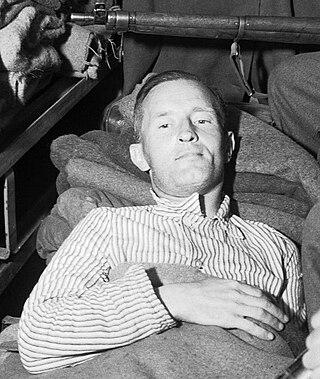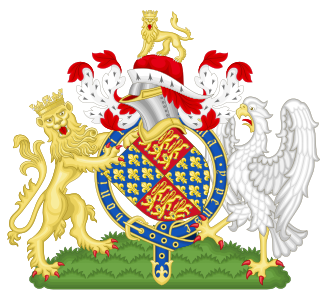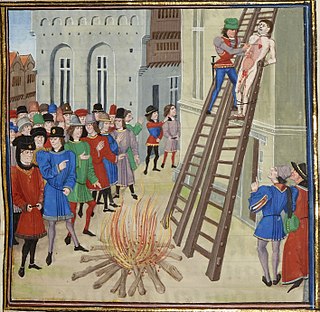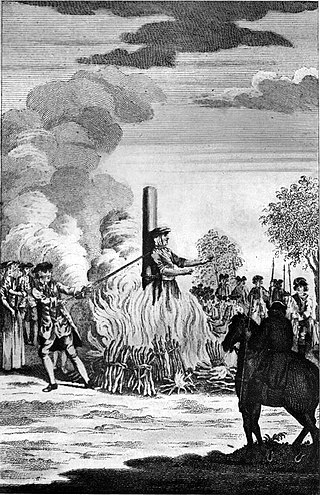In English law, the benefit of clergy was originally a provision by which clergymen accused of a crime could claim that they were outside the jurisdiction of the secular courts and be tried instead in an ecclesiastical court under canon law. The ecclesiastical courts were generally seen as being more lenient in their prosecutions and punishments, and defendants made many efforts to claim clergy status, often on questionable or fraudulent grounds.

Capital punishment in the United Kingdom predates the formation of the UK, having been used within the British Isles from ancient times until the second half of the 20th century. The last executions in the United Kingdom were by hanging, and took place in 1964; capital punishment for murder was suspended in 1965 and finally abolished in 1969. Although unused, the death penalty remained a legally defined punishment for certain offences such as treason until it was completely abolished in 1998; the last execution for treason took place in 1946. In 2004, Protocol No. 13 to the European Convention on Human Rights became binding on the United Kingdom; it prohibits the restoration of the death penalty as long as the UK is a party to the convention.

Under the law of the United Kingdom, high treason is the crime of disloyalty to the Crown. Offences constituting high treason include plotting the murder of the sovereign; committing adultery with the sovereign's consort, with the sovereign's eldest unmarried daughter, or with the wife of the heir to the throne; levying war against the sovereign and adhering to the sovereign's enemies, giving them aid or comfort; and attempting to undermine the lawfully established line of succession. Several other crimes have historically been categorised as high treason, including counterfeiting money and being a Catholic priest.
Capital punishment in Canada dates to Canada's earliest history, including its period as first a French then a British colony. From 1867 to the elimination of the death penalty for murder on July 26, 1976, 1,481 people had been sentenced to death, and 710 had been executed. Of those executed, 697 were men and 13 women. The only method used in Canada for capital punishment of civilians after the end of the French regime was hanging. The last execution in Canada was the double hanging of Arthur Lucas and Ronald Turpin on December 11, 1962, at Toronto's Don Jail. The National Defence Act prescribed the death penalty for certain military offences until 1999, although no military executions had been carried out since 1946.
Petty treason or petit treason was an offence under the common law of England in which a person killed or otherwise violated the authority of a social superior, other than the king. In England and Wales, petty treason ceased to be a distinct offence from murder by virtue of the Offences against the Person Act 1828. It was abolished in Ireland in 1829. It never existed in Scotland. It has also been abolished in other common-law countries.
Capital punishment was abolished in 2019 in New Hampshire for persons convicted of capital murder. It remains a legal penalty for crimes committed prior to May 30, 2019.

Capital punishment – the process of sentencing convicted offenders to death for the most serious crimes and carrying out that sentence, as ordered by a legal system – first appeared in New Zealand in a codified form when New Zealand became a British colony in 1840. It was first carried out with a public hanging in Victoria Street, Auckland in 1842, while the last execution occurred in 1957 at Mount Eden Prison, also in Auckland. In total, 85 people have been lawfully executed in New Zealand.

Arson in royal dockyards and armories was a criminal offence in the United Kingdom and the British Empire. It was among the last offences that were punishable by capital punishment in the United Kingdom. The crime was created by the Dockyards etc. Protection Act 1772 passed by the Parliament of Great Britain, which was designed to prevent arson and sabotage against vessels, dockyards, and arsenals of the Royal Navy.

The Treason Act 1351 is an Act of the Parliament of England wherethrough, according to William Blackstone, common law treason offences were enumerated and no new offences were, by statute, created. It is one of the earliest English statutes still in force, although it has been very significantly amended. It was extended to Ireland in 1495 and to Scotland in 1708. The Act was passed at Westminster in the Hilary term of 1351, in the 25th year of the reign of Edward III and was entitled "A Declaration which Offences shall be adjudged Treason". It was passed to clarify precisely what was treason, as the definition under common law had been expanded rapidly by the courts until its scope was controversially wide. The Act was last used to prosecute William Joyce in 1945 for collaborating with Germany in World War II.

The Murder Act 1965 is an act of the Parliament of the United Kingdom. It abolished the death penalty for murder in Great Britain. The act replaced the penalty of death with a mandatory sentence of imprisonment for life.

The Treason Felony Act 1848 is an Act of the Parliament of the United Kingdom of Great Britain and Ireland. Parts of the Act are still in force. It is a law which protects the King and the Crown.

The Treason Act 1790 was an Act of the Parliament of the Kingdom of Great Britain which abolished burning at the stake as the penalty for women convicted of high treason, petty treason and abetting, procuring or counselling petty treason, and replaced it with drawing and hanging.
Treason Act or Treasons Act or Statute of Treasons is a stock short title used for legislation in the United Kingdom and in the Republic of Ireland on the subject of treason and related offences.

Capital punishment in the Republic of Ireland was abolished in statute law in 1990, having been abolished in 1964 for most offences including ordinary murder. The last person to be executed was Michael Manning, hanged for murder in 1954. All subsequent death sentences in the Republic of Ireland, the last handed down in 1985, were commuted by the President, on the advice of the Government, to terms of imprisonment of up to 40 years. The Twenty-first Amendment to the constitution, passed by referendum in 2001, prohibits the reintroduction of the death penalty, even during a state of emergency or war. Capital punishment is also forbidden by several human rights treaties to which the state is a party.

To be hanged, drawn and quartered was a method of torturous capital punishment used principally to execute men convicted of high treason in medieval and early modern Britain and Ireland. The convicted traitor was fastened to a hurdle, or wooden panel, and drawn behind a horse to the place of execution, where he was then hanged, emasculated, disembowelled, beheaded, and quartered. His remains would then often be displayed in prominent places across the country, such as London Bridge, to serve as a warning of the fate of traitors. The punishment was only ever applied to men; for reasons of public decency, women convicted of high treason were instead burned at the stake.

The Treason by Women Act (Ireland) 1796 was an act of the Parliament of the Kingdom of Ireland which reduced the penalty for women convicted of high treason and petty treason from death by burning to death by hanging. It was the Irish equivalent of the Treason Act 1790 passed by the Parliament of the Kingdom of Great Britain.

Capital punishment was outlawed in the State of New York after the New York Court of Appeals declared it was not allowed under the state's constitution in 2004. However certain crimes occurring in the state that fall under the jurisdiction of the federal government are subject to the federal death penalty.

The Coinage Offences Act 1832 was an Act of the Parliament of the United Kingdom of Great Britain and Ireland. It consolidated into one Act all offences concerning the counterfeiting and clipping of coins. Such conduct was often considered to be high treason: this Act downgraded the offence to felony and abolished the death penalty for all coinage offences.

The Poisoning Act 1530 was an Act of the Parliament of England. Its long title was "An Act for Poisoning." It made it high treason to murder someone with poison, and instead of the usual punishment for treason it imposed death by boiling.

In England, death by burning was a legal punishment inflicted on women found guilty of high treason, petty treason, and heresy during the Middle Ages and Early Modern period. Over a period of several centuries, female convicts were publicly burnt at the stake, sometimes alive, for a range of activities including coining and mariticide.













